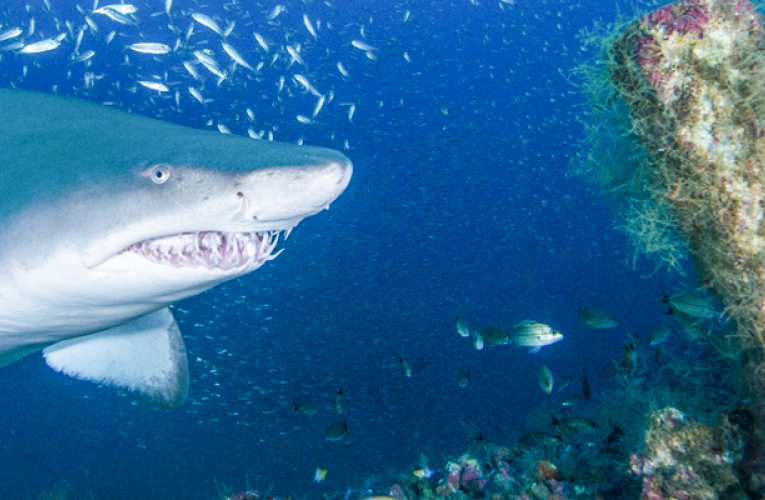Media Contact: Tim Lucas (919) 613-8084, tdlucas@duke.edu
Note to Editors: Avery Paxton is available for additional comment at avery.paxton@duke.edu.
DURHAM, N.C. -- Photos taken months, and in some cases years, apart by scuba divers show female sand tiger sharks returning to the same shipwrecks off the North Carolina coast, a new study co-led by scientists at Duke University reveals.
This display of “site fidelity” by the sharks suggests the shipwrecks are important habitats for the fierce-looking but docile species, which experienced dramatic population drops toward the end of the last century and is listed as globally vulnerable by the International Union for Conservation of Nature (IUCN).
“Their population is estimated to have dropped by as much as or more than 75% in the 1980s and 1990s and we don’t know if it has stabilized or is still declining, in large part because we’ve mostly had to rely on anecdotal sightings,” said Avery B. Paxton, a visiting scholar at the Duke University Marine Laboratory in Beaufort, N.C., who was lead author of the study.
“Having photographic evidence that these wrecks form an important habitat the sharks return to from time to time gives us a focal point for ongoing research so we can better understand how the species is faring,” she said.
“We’re now trying to figure out why they return. They could be using the wrecks as rest stops along their migratory paths, but they could also be returning here for mating or possibly to give birth. There are all kinds of hypotheses our team is testing,” said Paxton, who formerly was a postdoctoral researcher at the South-East Zoo Alliance for Reproduction & Conservation.
She and her colleagues published their peer-reviewed paper April 22 in Ecology.
Having access to photos taken by citizen scientists, including images uploaded to the Spot A Shark USA program led by the North Carolina Aquariums, was vital to the study’s success.
“This area is called the Graveyard of the Atlantic for a reason -- it has hundreds of wrecks. As researchers, we can’t have eyes underwater at each of them,” Paxton said. “Being able to rely on scuba divers and other citizen scientists who are out there and have cameras with them extends our reach.”
Each sand tiger shark has a unique pattern of brown spots on its skin that acts like a fingerprint, allowing scientists to identify individual sharks and distinguish them from others of their species.
By analyzing and comparing the spot patterns on sharks in divers’ photos dating back to 2007, Paxton and her colleagues identified six female sand tiger sharks that have returned to the same wrecks, or to similar wrecks close by, at intervals ranging from one to 72 months apart.
“This is the first time we’ve been able to document site fidelity to habitats in offshore waters along the East Coast,” Paxton said. “Previous studies have shown similar behavior patterns in Australia and Africa and in estuarine habitats such as Delaware Bay, so what we are finding off North Carolina definitely fits into global patterns.”
Male sharks may also exhibit site fidelity to wrecks off the North Carolina coast, but so far no matching photos have been found to prove it.
That may change as more and more citizen scientists share their images, said Hap Fatzinger, director of the North Carolina Aquarium at Fort Fisher and a co-author of the study.
“Through collaborations and strong partnerships, Spot A Shark USA is engaging recreational divers to become citizen scientists and provide essential data to expand our knowledge,” Fatzinger said. “By increasing community engagement, we are creating stronger connections to local, regional and global concerns for sharks and healthy ocean ecosystems.”
Erica Blair, a graduating senior at Duke and a co-author of the new study, helped map the unique spot patterns on the sharks’ skin that were used to confirm their identities. Brian Silliman, Rachel Carson Associate Professor of Marine Conservation Biology at Duke’s Nicholas School of the Environment, also co-authored the study.
Other co-authors were from the South-East Zoo Alliance for Reproduction & Conservation; the University of North Carolina at Chapel Hill; the North Carolina Aquarium at Pine Knoll Shores; the University of North Carolina-Wilmington; the nonprofit Wild Me; Blue Elements Imaging; and the Coastal Studies Institute at East Carolina University.
Funding for the Spot A Shark USA program was provided by the North Carolina Aquarium Society, the Georgia Aquarium and the Minnesota Zoo Foundation. Additional support for the research came from the Maritime Aquarium at Norwalk and the New York Aquarium/Wildlife Conservation Society.
CITATION: “Citizen Science Reveals Female Sand Tiger Sharks (Carcharias taurus) Exhibit Signs of Site Fidelity on Shipwrecks,” Avery B. Paxton, Erica Blair, Camryn Blawas, Michael H. Fatzinger, Madeline Marens, Jason Holmberg, Colin Kingen, Tanya Houppermans, Mark Keusenkothen, John McCord, Brian R. Silliman and Linda M. Penfold. Ecology, April 22, 2019. DOI: 10.1002/ecy.2687
###



